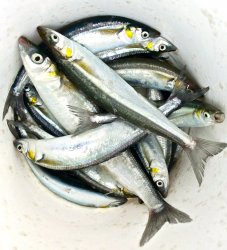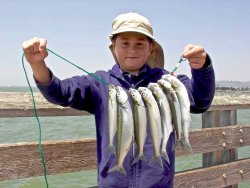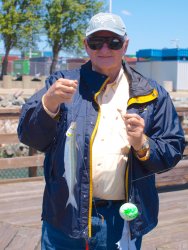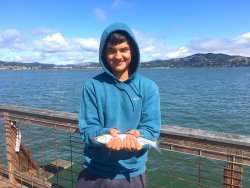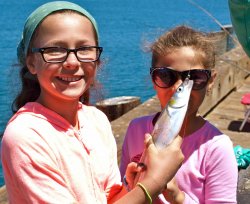A jacksmelt from the Cayucos Pier
Species: Atherinopsis californiensis (Girard, 1854); from the Greek words ather (a spike or arrow) and ops (like), and californiensis (in reference to the geographic area).
Alternate Names: Smelt, California smelt, horse smelt, blue smelt, silverside, pescado del rey, Peixe rey and Pesce rey. Called pejerrey mocho in Mexico.
Identification: Smelt-like shape and very similar to the topsmelt. They have two dorsal fins; the anal fin begins below the first dorsal fin. Their coloring is grayish-green above with a bluish tinge, silver below. A metallic band tinged with blue and edged with bright blue extends the length of the body. The cheek has a yellowish blotch.
Size: To 19.1 inches. In southern California, anglers catch both jacksmelt and topsmelt and most of the fish are small. Occasionally a few larger fish do appear, with almost any fish over 12 inches being a jacksmelt. In northern California, the majority of smelt appear to be over 12 inches in length. The California angling record fish weighed 1 lb. 8 oz. and was caught near San Nicholas Island in 1998.
Range: From Bahia Magdalena, southern Baja California, and the Gulf of California, to Yaquina Bay, Oregon. Common from Bahia Magdalena, Baja California, to Coos Bay, Oregon.
Habitat: Bays and nearshore, shallow oceanfront water, especially near rocky areas like jetties where there is a good current to sweep food near the fish. Recorded to a depth of 95 feet.
Piers: Jacksmelt are caught at virtually every pier in California. Larger jacksmelt are especially abundant at piers in bays, and even more so at bay piers adjacent to rocky points. Best bets: Ocean Beach Pier, Oceanside Pier, San Clemente Pier, Balboa Pier, Newport Pier, Huntington Beach Pier, Hermosa Beach Pier, Gaviota Pier, Pismo Beach Pier, North T-Pier Morro Bay, Fort Point Pier (San Francisco), Robert E. Wooley Pier (Burlingame), Port View Park Pier (Oakland), Marin Rod & Gun Club Pier, Elephant Rock Pier (Tiburon), Fort Baker Pier (Sausalito), Commercial Street Dock (Eureka), “B” Street Pier (Crescent City).
Shoreline: Sometimes taken by inshore anglers fishing near rocks or jetties.
Boats: Sometimes taken by boaters, especially those fishing Morro Bay and San Francisco Bay.
Bait and Tackle: Two main outfits are used. First is a simple snag line made with several small hooks, either left bare or to which colored yarn or cloth has been attached (like a Lucky Joe rigging). This is commonly used in southern California and the angler simply jigs the leader up and down trying to attract and snag the fish. In northern California, a leader is usually made up with six to eight small hooks spaced every six inches apart. A float or large bobber is attached above the hooks. Each hook is baited with a very small piece of pile worm, bloodworm or shrimp and the outfit is allowed to drift with the current. The result is often 3-6 fish caught at one time. However, in San Francisco Bay the limit is three hooks.
Food Value: Given their size, fillets are typically small. The flesh is mild flavored and soft textured with moderate fat content. Typically pan-fried although there are a lot of bones and usually quite a few worms in the flesh. The worms are harmless after cooking but seem to prevent many from eating the jacksmelt.
Comments: For their size jacksmelt put up a terrific fight. Many anglers have been startled to have a jacksmelt hit a bait at full throttle and come to realize that a fairly small fish has put up such a terrific battle.


